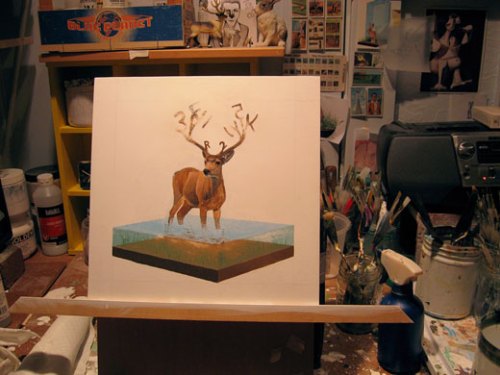
In the submerged, subtracted sectors where drowned polar bears are found and freshly sliced elk survey a landscape choked by the clamor of smoking spewing engines in the company of signs signifying rules and regulations sprouting from the debris and trash of a seemingly increasingly less civil civilization, here in the twilight of the kingdom of kitsch and the under the closed – circuit eye of big brother, here, Josh Keyes reigns supreme.
His is a work that doesn’t make for a clean categorical fit. It’s not a body of work that couldn’t easily be called pop surrealism nor is it wholly Post-structuralist. Though one must as usual and especially in this case – note that such classifications are at best blurry and at worse vulgar – even at times Orwellian, lacking so much in information and more so an exercise in crass marketing.
I have written of Mr. Keyes’ work in the past, and I found his work hard to criticize due to the kind spirit of the man himself and the strength and freshness of his art. Josh Keyes is one of the most naturally personable and down to earth artists I’ve met in the last few years covering the local art world in the web and in print. His work speaks to a world in crisis and to heart of man in time of confusion and catastrophe.
I recently had the pleasure of sitting down Josh at his Temescal studio to discuss the violence of pollution, aesthetic breakthroughs, and other assorted influences.
————————————————————————————
THEO KONRAD AUER:
For me the best political art is work that is as personal as it is partisan. Your art has been, for me, acutely focused…working alternately as a mediation on and dialogue – speaking to such topical issues as environmental devastation, the conflicts and costs inherent to urbanization, and the personal emotional toll of such shocks to one’s system. You grew up in Tacoma, so you saw the effects of logging practices on the local forests around you – how much, would say your upbringing affected you as an artist both personally and politically?
JOSH KEYES:
My experience growing up in the Pacific Northwest was deeply rooted to an admiration and respect for the wildlife and surrounding landscape. Anywhere you are in Puget Sound, you are aware of the striking silhouette and form of Mount Rainer. There was another dominant feature to the landscape that sticks in my memory. It was the tall smoke stack of the ASARCO Tacoma Smelter that was detonated and demolished about 15 years ago after research had found high levels of arsenic in the surrounding soil of and water of our neighborhood. A strong influence on my political and environmentalist awareness and development came from my mother. Being part of the 60’s generation her passion and ideas about civil rights, the feminist movement, and the antiwar movement had a lasting effect on my political views. She is also an artist. I remember walking with my mom along Tacoma’s Ruston Way back in the early 70’s and we both noticed an alarming amount of dead fish washing ashore. After this experience, she spent many hours at the public library, researching the possible cause for this occurrence. It turned out that the St. Regis Paper Company was polluting the Puget Sound waterway, and was eventually shut down a few years later. My mom made a series of sculptures based on her research. Having parents who were both artists and politically active made it very clear that creating political art can address both political and personal issues
Another important experience in my life that brought art and politics together was during my years as a student at the Art Institute of Chicago. The year I arrived at the school, the artist/activist Dred Scott had an interactive artwork on display in the student gallery titled, “What is the proper way to display the American flag?” It was a simple conceptual piece that had a shelf with an American flag and I think there was a small book that you could write comments in. The piece invited the viewer to engage in the dialogue. The option for the viewer was to either place the flag on the floor, or to carefully fold it, and put it on the shelf. Word got out about the piece and in a few days time, police and Vietnam veterans holding guns surrounded the school. It was terrifying. Dred Scott received a number of death threats and many students did not feel safe going to school. There were sit ins, all school forums on the topic of freedom of speech, the rights of the students to express themselves vs. the roll and responsibility of the school to provide a safe environment to it’s student and faculty. It was an important issue of the freedom of speech, the responsibility of the artist, and the delicate diplomatic balance the Art Institute played between the students and faculty of the school, the Chicago Art Museum, and the public. About a year later, the Persian Gulf War began, and the students organized a number of protests and marches with local antiwar organizations that shut down traffic in down town Chicago. The studios at SAIC were full of students discussing the war, and making work that either supported the war or stood in opposition to the war. It was one of the most electrifying times of my life. Many students were worried and trying to decide what to do if there was a draft.
Years later, we are still at war and the concern I have is the lack of political art being made in the schools and community around the country. Perhaps it is no longer disturbing and has become too familiar, and in a way comfortable. It is easy to feel powerless in these situations, but I feel artists, writers, musicians, filmmakers, actors… have an important responsibility to comment and express their views during times like this. I think of Goya, Picasso, Francis bacon, Kathe Kollwitz, Ed Kienholz, Warhol, and so many others who found a way to express their views about war through their art. It is important to look back at these artists and to recognize a parallel with their expression and match it with the tools and conventions of our time. Though anti expression or escapism can also be a powerful statement in terms of responding to global crises.
TKA: What has inspired and informed your ongoing dialogue with man and animal nature amongst man’s constructions?
JK: I think just living in the world, and observing where the line between things made and the natural environment or surroundings come together. Like oil and vinegar, sometimes the line is clear and sometimes it difficult and complex to see how our development and use of natural resources is changing the dynamics of the ecosystem and the world we live in. Our family visited a number of museums when I was young and I remember being fascinated by the art of the Northwest Native American tribes. I was especially moved by the imagery of the masks and totem poles. Since that time, I have continued to research and read about animal stories and legends around the world. The respect and reverence the Indians had for the environment and animals that shared it with them is an important issue and idea that is central to my imagery and work.
TKA: Tacoma. Chicago. The Bay Area. Three places as different as can be. What have you ‘taken’ from these places that one can see in your work?
JK: I think living in different areas adds to your conception and thinking of the world as a whole. It has been important for me in terms of finding a location and area that I feel at home with. Though I enjoy the buzz and hustle of Chicago, the winters are too cold and windy to describe in words. Tacoma, at the time was just a little too small for my taste, though over the years, it has grown into a strong city that supports the arts. I fell in love with the bay area the moment Lisa and I arrived here 9 years ago. Having two parents who were active in the 60’s, I had romanticized the Bay Area as a radical hot spot, and having watched the film, Berkeley In the Sixties, I had idealistic notions that Peoples Park would still be full of barefoot hipsters and serving free food. This area is still one of the most liberal and tolerant areas I have ever lived in. There are echoes of its historic events, and I still get chills walking down telegraph and seeing the US Army induction center in Oakland, and remembering the shocking events that took place there not so long ago, and thinking of the current state of affairs today. To answer your question, there are aspects of the city and landscape that through my travels have found a place of expression in my work. But more importantly, being an artist in this part of the country feels right to me. Working in an area that has part of the civil rights movement, feminist movement, the source of the Black Panthers and the antiwar movement, I feel that the energy of those events is still buzzing under the pavement. That there is possibility for things to happen.
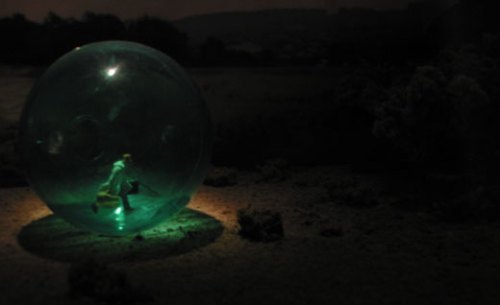
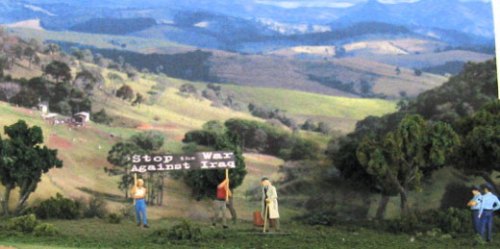
TKA: You utilize small scale modeled environments to help visualize your work? When did start doing that? How does that affect/help you when you are working?
JK: Around 11 years old, I began to develop a strong interest in sculpture and art. My parents let me use a room in our basement for a studio. I also enjoyed painting lead miniatures, and creating large dioramas out of dirt and small branches. It was around this time that I thought of going into special effects for film. Any spare minute I had, I was down in my studio creating back drops, and large epic battle scenes, but my mail passion at that age was paining highly detailed miniatures. It was only about five years ago that I thought about creating some sculptures using HO scale miniatures and models. Part of this came from my research on Jungian Sand play. Creating a miniature world or environment that could be compared to dreaming, or meditation. Playing with and arranging symbols, materials, and objects in a closed or compartmentalized space. I found a fantastic resource for this. One was Oakland’s East Bay Depot, Center For Creative Reuse, and the other was the model shop in the basement of the hardware store on University Ave in Berkeley. I found things that resonated with me, houses, animals, trees, and built small dioramas. Every morning, I created a habit or ritual of manipulating the diorama in some way, either in terms of an ongoing continuous narrative, or a random arbitrary change. I did this for a while and would sometimes take photographs. I feel that my paintings serve a similar function, creating dioramas serves an entirely private form of expression and painting is a bridge or communicates to a larger audience. Sometimes, I will start a painting without an idea and just see what happens, first a plot of earth and then see where it goes.

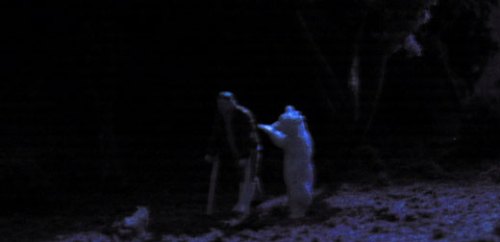
TKA: You use quite a bit of illustrative imagery in your work – where do you find this stuff!…?
JK: I use many different resources to create my work. Anything from old National Geographic’s, and magazines, animal toys and sculptures, the Internet, and my own photographic references. I also construct a number of objects out of Styrofoam and clay as a painting reference.
TKA: It is interesting how central and integral such illustrative semiology is to your body of work. That is something of a rarity in your particular “corner” of the art world. Usually such imagery is an element and only just. In you work however you break the trend the elemental symbolic illustrative imagery…was/is this direction intentional is was it accidental?
JK: As an artist, and a person who loves visual art, I am attracted to iconic imagery. Our culture is full of visual icons, and there is a visual vocabulary that and hierarchy that comes with living in a consumer society. Like any form of propaganda, the repetitive nature of information and images we see in commercials and advertising has a lasting numbing and comforting effect. It also conditions our ability and capacity to read visual information. My work begins with a personal response, reaction or expression. The challenge for me is to give form and expression to that feeling or idea. I am interested in images that can be read, and look through the history of art and contemporary advertising and culture for clues to find the moments of immediacy and resonating compositions. I think symbols are important but they are limited in their expressive potential. Decontextualizing a symbol or juxtaposing one symbolic form with another creates tension and possibility for reading that symbol in a new context. The introduction of story or narrative in conjunction with an icon or symbol also adds a new perspective on the reading of the image or artwork.
TKA: Segmented (M.C.) Escheresque cities figure prominently in your art, particularly your earlier work. Pop culture ephemera and trash litter and threaten to choke these fragile floating worlds. The work strongly recalls some of Robert Williams drawings I saw quite a while back – I believe it was older work – even though your stylistic choices are decidedly less comix or graphic novel derived. Is he an influence? What are some of your influences(artistically or otherwise)?
JK: Most of my art history and conceptual framework for thinking and making art is based in a traditional study of art history. It wasn’t until I started teaching art at the Oakland School for the Arts about two years ago that I realized I was stuck in the late 1980’s as far as what I thought was hip and cutting edge. My students helped make the jump to light speed by introducing me to contemporary trends and styles of graffiti and what is known as Low Brow art which was poo pooed by many instructors I had at Yale. I have tremendous respect for Robert Williams – here is a painter who puts everything he loves and is obsessed about into his work. He has given artists permission to put the stuff of life be it ugly, stinky, beautiful, or disturbing into their art. Makes me think of some of the artists from the 1960’s especially Robert Rauschenberg who did just that put the stuff from his life in his work. The main difference is that Rauschenberg was responding to and in some ways acting in the accepted and elitism of abstract expressionism. Williams has resurrected figurative painting, allegory and found a way to mythologize the trash and billboards and urban legends into a kind of pictorial folklore. So much art is serious and Williams has found a way to bring humor and tongue in cheek to his work. I feel like I am trying to catch up with a movement that seems like it is on the verge of transforming. I don’t know how much of an influence the Low Brow or graphic novel culture has had or will have on my work, if anything it is reassuring to know that this type or style of art is taken seriously. Though all of these current styles are exciting, at the end of the day I find myself returning to looking at cubist painting, or Goya.
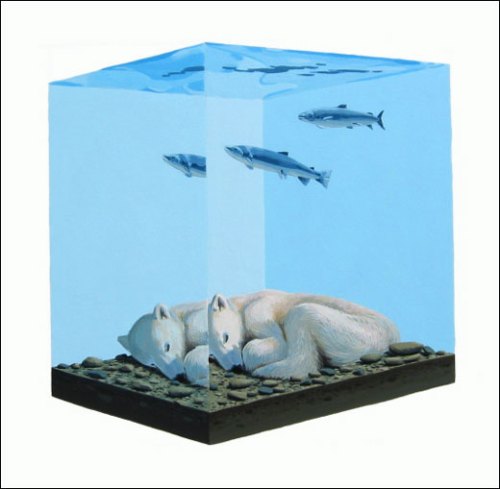
TKA: At your recent Hang Art show in S.F. you had a series of paintings featuring drowned polar bears laying in cubical suspended worlds – the work was particularly evocative. What inspired it? There seems to be a story here as this work is quite different from your other work…
JK: Those were difficult and highly personal paintings for me. At one point I debated even putting them in the show. They started from some research I was doing on the melting arctic ice, and the devastating long-term effect it might have on the bear’s hunting grounds. I kept getting something like visions of polar bears asleep at the bottom of the sea. If I were a filmmaker I would create something like Akira Kurosawa’s film Dreams, the scene with the mountain climbers who fall asleep in the snow, beautiful film. The idea also came at the time I received news that a friend of mine had passed away. So the work took on a cathartic feeling, in conjunction to being a comment on the environment it also served as a meditation on grief and loss. Though the bears appear to be dead, I like to think of them as hibernating, sort of waiting for humanity to get their shit together.
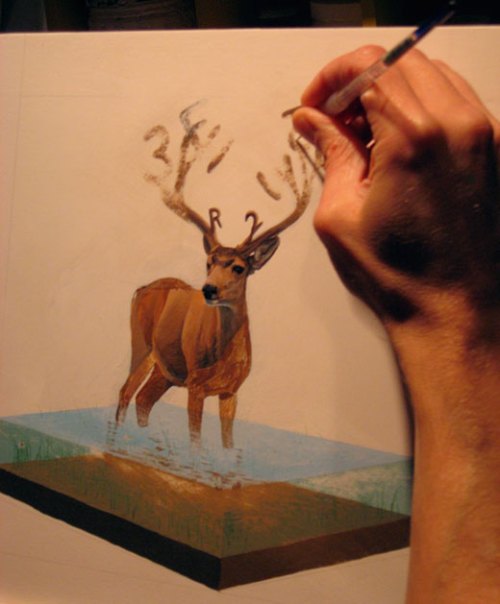
TKA: Going to back to your earlier work…thinking back on it I distinctly remember a seismic shift taking place in your art between “The Human Zoo” at Lobot Gallery in 2005 and the salon style show “Overhung 2” at Boontling Galley. To be frank, the first time I saw your work to me it was intriguing but only borderline noteworthy. Then at Overhung, I thought to myself was this the same guy – cause’ the work was more compelling, more together…polished. Then with your show with Kyle Mock at Boontling – at that point you seemed be a much more fully matured artist. The work stood on its own for me at that point. I know this is a loaded question, but what happened? How did you get here from there?
JK: I think quitting my job was a big shift. It was a full commitment to making art full time, and putting everything I had into the process. I became extremely focused and became critical and aware of every step in making the work. It was also the first real moment that I truly believed that I could do this the rest of my life, and make a decent living. I had also preached this to my students while I was teaching, I told them that if they wanted to, they could do what they love doing and make it their life’s work. So the changes in my work and decision to do this full time was to set an example for my students that they could make a living off their art if they work hard.
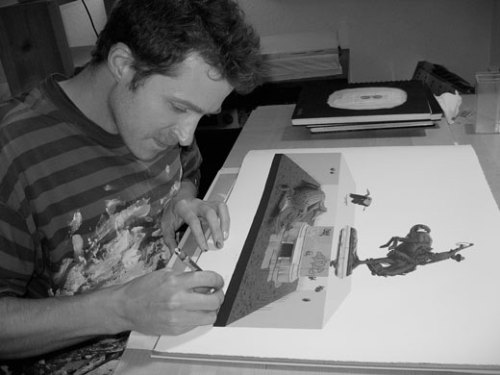
TKA: During my studio visit with you we spoke of politics and crime in Oakland and how such matters affect our art community? On that subject…according to one source, Oakland has more artists living in it than any other place in America save New York. People have said for years Oakland is on the verge of ‘blowing up’. Now having said all this, Oakland still struggles with severe crime issues and economically as well. the art scene here as well as the greater Bay Area – still isn’t on the ‘art world map.’ You have taught here and lived here for eight years, so I think you would have some keen insight on this. Why is Oakland so buzzed about, yet still can’t seem to shake its many demons(crime, poverty, troubled school system…)?
JK: That is a monster question, I can only speak to what I have seen and heard over the few years I have lived here. I am not familiar with the deeper history of Oakland or how the population has changed over the last fifty or sixty years. It makes me sad to hear on the news on a regular basis that someone has been shot, and to see the crosses and flowers on street corners. I don’t think this is an isolated case, though I know Oakland has a reputation for high crime rates. It seems to be an epidemic that is emerging all around the country. Having taught in the Oakland public schools, I had an opportunity to hear some of the challenges that face many young people today. The key that I kept hearing was a need for respect, acceptance, and equal opportunity. The critical part was self-confidence and the belief in themselves that they could be successful and have a lasting influence in the community and the world. I know that there are many music, dance, poetry and spoken work, and hip hop organizations that serve Oakland’s youth. I believe we need more of them; these voices are valuable and need to find expression in the community and the world.
As far as Oakland having one of the largest artist populations in the country, I think it’s great. Oakland so far, (knocking on wood) is relatively cheaper than living in San Francisco, there are a number of industrial buildings, and loft space, fantastic start up galleries like RPS, Mamma Buzz, Lobot, including R.I.P. Boontling and 33 Grand. Again I feel that the current art movements in Oakland are still thriving on… – or is a parasite to the radical history of this area? It has become a laboratory for artists who want to experiment, create collective art spaces, etc. It is also the home to many Burning Man tribes. Over time, I envision that as the artists establish an active community as they have done, the developers and corporate businesses will begin moving in and buying up property and turn it into another Bay Street Mall. Pros and cons, nothing new, over time many of the people who own houses or who are renting and just trying to get by will be forced to move as their neighborhoods gradually transform into urban lofts and retail spaces. Even the artists who helped to create the rich soil for investors and developers will no longer be able to afford to pay for their studio spaces and galleries. At least that is usually how it happens in other areas. Perhaps that fact that this is the Bay Area and there are fierce individuals here and a strong desire to work collectively, the established galleries, artists, and surrounding communities can work together to forge new legislation that will protect this unique art community from corporate developers.
TKA: Is the art scene blowing up here(or not)? Why or why not? What are some of the implications of this?
JK: I assume blowing up is a good term? Yes as far as I can tell, this is one of the most active art scenes I have ever witnessed. There are so many things going on, the fantastic thing is that the scene is not governed by one dominant style. Every artist seems to be making art, and expressing himself or herself, in a way that makes sense to them. And the work is really strong. All I can say is that I hope it lasts, and if not it will be remembered as a high point in my life.
TKA: What does the future hold for you?
JK:Hopefully painting and making art for as long as I can.













